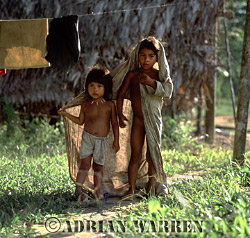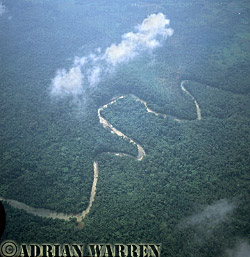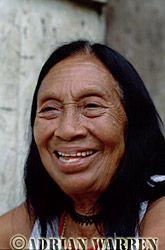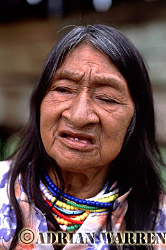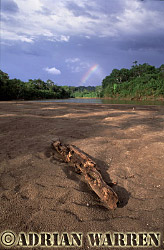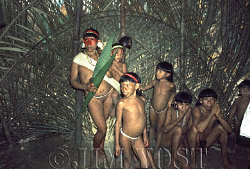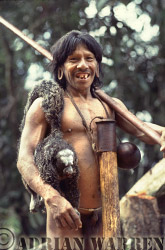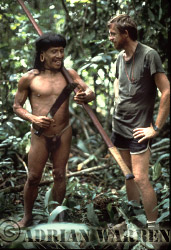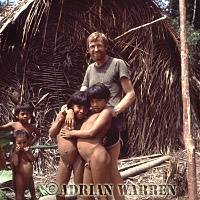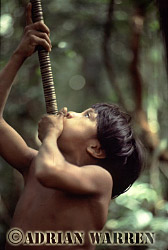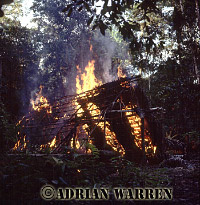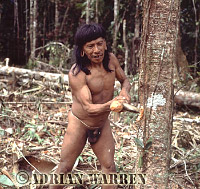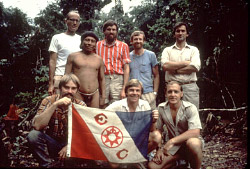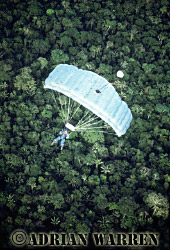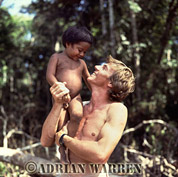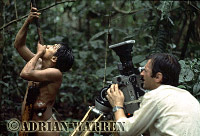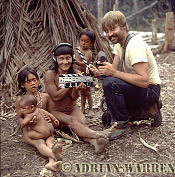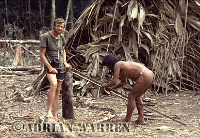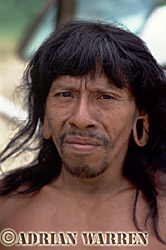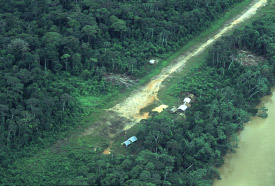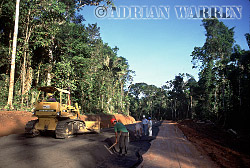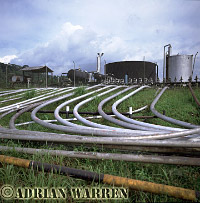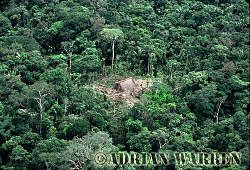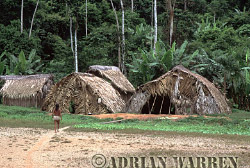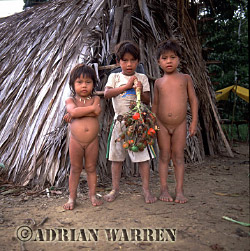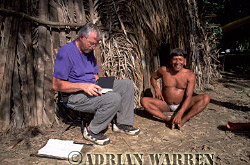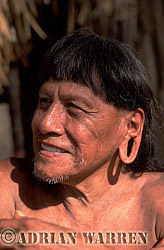WAORANI
The Saga of Ecuador's Secret People:
A Historical Perspective
© Adrian Warren, Last
Refuge Ltd., March 2002, in association with Dr. James Yost
"How can the Indians assume goodwill when we ferret them out so relentlessly? ... We approach them from the sky, the sphere which they do not control ... We are offering them unknown territory for known, a foreign land instead of home, dependency for self sufficiency, subjection to outside powers instead of resistance, and hunger where once there was plenty.
Quote from a Missionary, reflecting on his life
For most of us, as individuals, life is defined by family and village; but on a grander scale, human migration, trade and the interpenetration of cultures are as old as the human experience. Globalization is not a phenomenon of the last decade, it is the human condition; as population increases, we need more room; the powerful relentlessly subdue the weak. Mankind has followed this universal pattern throughout history - whether in Europe, Asia, Africa, or the Americas. It is happening even now, in Amazonia; outsiders arrive, engulf, overwhelm, and consume, leaving a trail of irreversible destruction behind. It is a natural evolutionary process; it seems inevitable, and unstoppable.
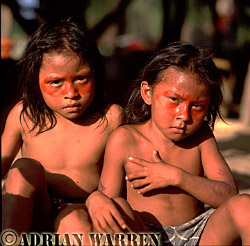
Waorani Indian girls: using Achiote
for face decoration, rio Cononaco, 2002
The history of the Waorani of eastern Ecuador, and for that matter all of the Amazonian tribes, is sketchy, but first contacts with outsiders were often both tragic and violent. Records show that explorers arrived in the Amazon in the sixteenth Century, when Gonzalo Pizarro, brother of Francisco Pizarro who conquered the Incas, allowed some of his lieutenants to follow the river Amazon to its mouth. Of the hundreds of soldiers who set out on this perilous journey, only a few survived the debilitating diseases and hostile tribes they encountered on the way. For Indians who had never seen white people before it must have been a terrifying encounter, and they defended themselves against the unwelcome intrusion. For the soldiers, fierce looking Indians who could move silently through the undergrowth and strike without warning, usually at night, became formidable adversaries.
In spite of the hostility of the environment and the Indians, more and more outsiders ventured into the Amazon; among the first were rubber gatherers, gold prospectors, and enterprising merchants. These men, eking out a hard life far from familiar home surroundings, often became unscrupulous, plundering villages, raping Indian women, enslaving young men, and murdering others. Many Indians died from diseases brought in by the strangers against which they had no resistance. It is no wonder that, for the Indians, outsiders were bad news.
The traditional lands of the Waorani lie in Ecuadorian Amazonia, where the foothills of the Andean Cordilleras flatten out to meet eight thousand square miles of tropical rain forest lying between the Napo and Curaray rivers. In the isolation of this remote territory, the Waorani have lived as semi-nomadic hunter gardeners for many centuries. But in the course of just one generation, their lives and their homeland have changed irrevocably.
(map in preparation)
Exploration for oil began on the fringes of Waorani territory in the early 1940's, but the companies soon encountered great difficulties because of Waorani violence and hostility. In January 1942, at Arajuno, a Shell Oil Company foreman and two Ecuadorian workers were speared to death by a band of Waorani Indians, led by a man called Moipa. It made news headlines for a shocked outside world, but was only the first of many such raids by these uncontacted Indians. By 1949, a total of twelve Shell employees had been killed by Waorani, forcing Shell to abandon their operations. The Waorani had earned a reputation as a tribe of hostile 'savages', or in the Quichua language, 'Aucas'. It would be almost another decade before any peaceful contact would be made; only then would the outside world begin to understand the extraordinary and unique nature of the Waorani. It would be revealed that they were a desperate people living in fear, not just the threat from outsiders, but with a culture so embedded in violence that they were afraid of themselves.
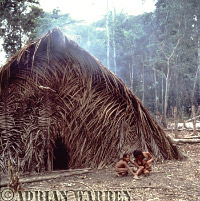
Waorani Traditional Hut, rio Cononaco,
1983
Soon after the Shell company killings, at the end of the forties, yet more tales of violence emerged. Two Waorani girls, Dayuma and Ome, chose to come out of the forest of their own accord, in order to escape a spate of vengeful spearing attacks and killings on their families by Moipa, the same man who had killed the oil workers. The girls fled the violence, throwing themselves at the mercy of the first outsider they came across. That outsider, Don Carlos, was the owner of a tea plantation, Hacienda Ila, and he took the girls to live as his slaves. Meanwhile, in the forest, the deadly vendettas continued, with killings and revenge killings. Moipa himself was eventually speared to death by other Waorani. Once accepted at Ila, Dayuma and Ome started doing manual work. Some time later, Rachel Saint, an American missionary from Wycliffe Bible translators, befriended them at the hacienda and started to learn their language. Little did Rachel know at the time that the consequences of her action would trigger a series of events that would change the lives of the Waorani forever.
At the base of the Andes, where the mountains meet the Amazon rain forest, at Shell Mera, Rachel Saint's brother Nate, together with four other American missionaries, were making a plan to attempt peaceful contact with the Waorani. While aware of the tribe's fearsome reputation for killing all outsiders, they nonetheless felt compelled to try to take the Gospel to the free living Waorani. Realising that it would take many months of preparation, one of the men, Jim Elliott, decided to learn a little of the Waorani language beforehand, and joined Rachel Saint to work with Dayuma at Ila.
Meanwhile, Nate Saint, a skilful pilot, devised an ingenious way of delivering gifts to the Waorani from his plane without landing. By banking his aircraft in a tight turn over a Waorani house, and once established flying in a tight circle, he would lower a canvas bucket containing presents on a piece of cord a quarter of a mile long. Due to centripetal force, the bucket would stay in the centre, allowing the recipients to safely approach and remove the contents. The first gift delivered by this method was a cooking pot with a lid, decorated with long ribbons, and containing brightly coloured buttons and some salt, was presented on 6th October 1955. The gift drops were carried out weekly, and on the 12th. November the Waorani responded by giving a present of their own; they tied a headband of feathers on to the line. This was seen as a breakthrough and an invitation, and plans were made for a contact expedition, to land a small plane on a sand bar the missionaries called 'Palm Beach' by the river Curaray, not far from the Waorani house. The Curaray is a shallow river with impressive meanders and extensive sand bars for much of its course, some of which are long enough to land a light aeroplane such as a Piper Family Cruiser.
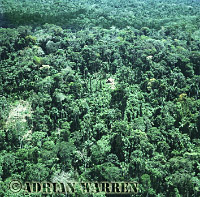
Waorani Traditional settlement,
Dywetomi, 1983
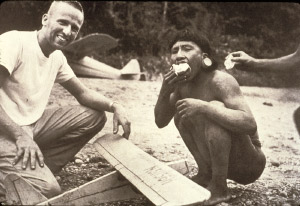
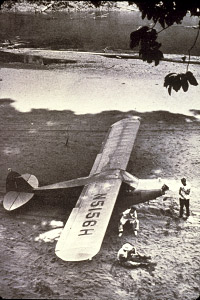 |
On the 3rd. January 1956, Nate Saint started ferrying his companions, Jim Elliott, Pete Fleming, Ed McCully, and Roger Youderian, and their survival equipment in his yellow Piper aircraft to the planned landing spot. The aircraft had been modified by installing a larger engine, more powerful brakes and a number of safety features; it had been ideal for the gift drops because of its ability to fly in circles at a low speed. The first landing was something of an experiment; Nate could not be sure that the sand would be firm enough to support the weight of the aircraft, but he came in on his final approach low and slow, and on touch down the extra large tyres worked well. It took many flights from the airstrip at Arajuno to 'Palm Beach' to ferry everyone and everything, but on the last flight, Nate circled low over the Waorani house before landing, to encourage them to come to visit them. Finally assembled at Palm Beach, they made a camp, with a tree house for extra security at night and they settled down to wait. |
|
They waited for three days until on the 6th. January three Waorani: Naenkiwi, a man of about thirty; Dayuma's teenage sister Gimari; and her aunt Mintaka; walked the four miles from the house to the riverbank where the aeroplane had landed. After initial greetings, Naenkiwi indicated, by drawing in the sand, that he wanted a ride in the plane, so Nate flew him over his house. The following day, Naenkiwi and Gimari went home. Naenkiwi, embroiled in personal tensions of his own making, concerning his relationship with Gimari, lied to the others that the missionaries had tried to kill them, that they were cannibals, and that they had also killed Dayuma. As a result, five Waorani men: Gikita, Dyuwe, Minkaye, Kimo and Nimonga plotted to kill the missionaries and made spears. On the afternoon of the 8th. January, the Indians attacked; the five missionaries were speared to death, and their bodies left by the river. Dayuma's brother Nampa was hit in the head by a bullet from one of the missionary's pistols, and died much later. |
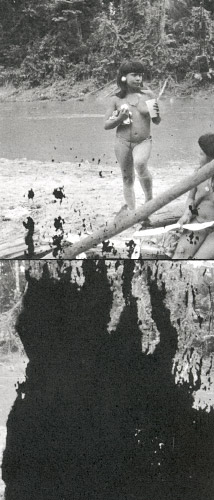 |
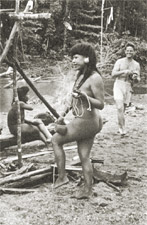 |
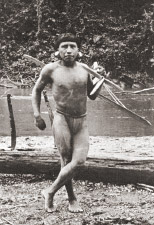 |
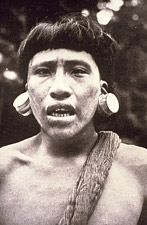 |
© Adrian Warren, Last Refuge Ltd., March 2002, in association with Dr. James Yost.
|
After the spearing
of the five Americans, which made world headlines, Dayuma heard
about yet more killings among her people. She wanted to do something
to stop these senseless acts, but she was afraid that, after
living with outsiders for nearly ten years, her people might
even kill her if she returned. But, two years after the terrible
spearing at Palm Beach, some of her relatives came out of the
forest looking for her and persuaded her to go back. So Dayuma
returned to her people on the Tewaeno river, where she heard
of her brother's death and found her people decimated by violent
revenge killings, weary of the spearings and living in fear.
Relieved and surprised to find Dayuma still alive after living
with outsiders, her Waorani relatives listened to her stories
about her cowode friends and saw an opportunity for change,
an escape from a life of endless fear.
|
Through Dayuma, the Waorani invited Rachel Saint and Elisabeth Elliott, one a sister and one a widow of the speared missionaries, to come to live with them. The invitation was accepted, and when the two American women travelled to the forest, the first ever peaceful contact with the Waorani was made. Rachel Saint and Elisabeth Elliott settled into a life with the killers of their loved ones and began to convert them to Christianity.
It has often been stated that the spearing of the five missionaries was the turning point in Waorani history. But the truly pivotal point was when Rachel and Elisabeth showed the Waorani that they were ready to forgive them for the killings. Forgiveness was a new concept to them, and it brought, for the first time ever, a possibility of peace, something the Waorani had longed for and sought for many generations, but had failed to attain. The appeal of the Christian message for the Waorani had more to do with the promise of an end to living in constant fear of spearing raids than any promise of an afterlife or relationship with God.
Rachel had been asked by the oil companies to persuade the Waorani to move from their scattered settlements to one place, to allow exploration to continue unimpeded. . The moves would be for their own safety, since ultimately the exploration would be unstoppable. Little by little, more and more Waorani families arrived to settle at the newly founded sanctuary at Tewaeno, seeking a new life without the constant fear of being killed. They persuaded the Waorani to build an airstrip so they could get in and out of Tewaeno without the arduous trip by trail. During the 1960s, as they moved out of the old hunting grounds and made way for oil exploration, raids and killings among the Waorani reduced. The area surrounding the village of Tewaeno became officially established as a protectorate for the Waorani by 1968. It was not a prison, however, and those who did settle there were free to come and go. Some of them did just that.
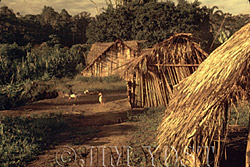 Tewaeno, 1973: Housing styles have varied in Waorani culture since pre-contact times |
In addition to acting as the catalyst for the cessation of killing, the missionaries served as a model for interaction with cowode. Because the missionaries attempted to identify with Waorani needs, the Waorani responded positively to the missionaries early on, but learned later that not all cowode intended to treat them so well. Some cowode wanted their land or its resources, others wanted cheap labour, and yet others wanted sexual access to their women. It took time for the Waorani to realise that not all cowode would treat them as well as they had come to expect from the missionaries.
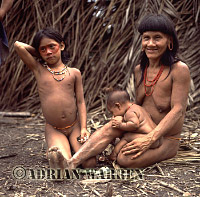
Use of ACHIOTE for decoration,
rio Cononaco, Ecuador, 1983
|
Some Waorani preferred to remain in the old hunting grounds, in spite of the fact that spearing raids continued between the different communities. Following a particularly vicious raid, one of the groups, led by a Waorani called Tagae, in fear of reprisals and for their own safety, fled. They began to live in self imposed isolation, and killed anyone who approached them including their own close relatives, believing it was safer that way than to risk reprisals. As time passed their anxiety, and their notoriety, increased. During the sixties, eleven attacks by Tagae's group resulted in the deaths of twenty outsiders. Meanwhile, among other isolated groups still living traditionally, the old fears and deep hostilities lingered on. One of these groups, living on the Gabado river, included a man called Caempaede. |
|
Tonyae, a Wao* living at Tewaeno, was related to Caempaede, and went to contact the group at Gabado in an effort to persuade them to come to live in peace with others at the protectorate. When Tonyae arrived, Caempaede's group seemed to accept him; and, in preparation for contact with outsiders, they even help Tonyae cut an airstrip, but then Caempaede's group grew nervous. They killed Tonyae with an axe, and then fled the area, fearing reprisals. When Tonyae did not return to Tewaeno, Rachel Saint and Dayuma flew over the area around Gabado, calling to Caempaede's group through a loudspeaker fixed on to the aircraft. Some of the group were persuaded that it would be safe to meet them at the new airstrip that had been cut with Tonyae. This peaceful meeting paved the way for more regular contact, and it was then that Jim Yost, a young American anthropologist working under the auspices of a missionary organisation called the Summer Institute of Linguistics, first met Caempaede and the rest of his community. It was the beginning of a long relationship for Jim and the Waorani, based on a growing friendship and trust. * "Waorani" is plural. "Wao" is the singular form; also, when used as an adjective, it is usually Wao house, Wao language etc. |
Caempaede's group at Gabado started moving, a few at a time, to the protectorate at Tewaeno. Soon afterwards, Tagae's group raided those still remaining at Gabado and, in fear for their lives, the survivors of Caempaede's group also moved out. It was now 1975, but after only a short time living in the Protectorate, Caempaede's group decided that the new lifestyle did not suit them and, in spite of the continuing danger from Tagae, they returned to their homeland at Gabado, in 1976. Jim Yost had continued his contact throughout this period and began his studies. It was an unique opportunity: a chance to observe for the first time a people who had been isolated for Centuries, and whose origins were a mystery
Even while Jim was studying the Waorani culture, the killings, in feuds and raids, continued, although their frequency gradually reduced due to increasing missionary influence. Apart from their extraordinary history of homicide, a further twenty per cent of Waorani deaths were caused by shootings by outsiders; and another five per cent died from snake bites.
|
|
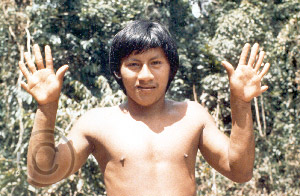 |
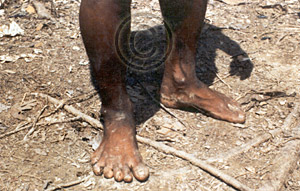 |
Six fingers ............ and six toes
|
Waorani Indians: family grooming, 1983 |
Amazingly, even amid the turbulent way of life led by the Waorani, the underlying culture of the tribe maintained strong social ties: an egalitarian society with no concept of competition or rank, where children had nearly the same status as adults. And there was greater equality between the sexes than within Western culture between men and women, even if there were separate roles; while men hunted, women planted the gardens and prepared the food. They even used stone axes, treasured objects and fiercely protected, found, remarkably, as archeological artifacts in the forest, discarded by other peoples from another time. Living as semi-nomadic hunter gardeners, and because of the violence, they needed to roam a huge area in order to survive. |
|
They traditionally lived in small groups of thirty to forty people, remaining in any one place for only a few months, during which time they hunted, prepared gardens for growing manioc, and took note of the whereabouts of trees, vines, and other plants essential to their lifestyle. While they harvested one garden, they simultaneously planted another next to it. Once hunting in the area became less successful, they burned the house and moved on, repeating the process at a new location, and returning in time to harvest the gardens when the manioc was ready. It was a cycle of life that was in equilibrium with their forest home, but they were continually on the move, and that's why they needed so much space. |
|
Traditionally, the Waorani had no form of writing; no reason to count beyond ten; and are one of those rare groups to be classified as linguistic isolates - people whose language bears no resemblance to any other in the world. Their ethnic origins are obscure: no one knows how large their population may once have been. Their environment offers almost insurmountable difficulties for archaeological research, since their day to day material needs were mainly of plant origin and are therefore ephemeral. |
Continuing his studies, Jim built a house in a Waorani village and brought in his wife and children. During this period at the Protectorate, there were up to two hundred Waorani lived in the village of Tewaeno at any one time. Under the influence of the Missionaries, they were learning to be peaceful with one another and to interact with the outside world. Rachel Saint was busy translating the New Testament into the Waorani language, and efforts were being made to contact any Waorani communities still remaining in the old hunting grounds.
Dayuma, and her half Quichua son Sam, were themselves becoming more integrated with the outside world and began to establish a new settlement, not far away, at Tonaempaedi. While the more traditional Waorani stayed at Tewaeno, those who moved to Tonaempaedi convinced the Ecuadorian government to establish Spanish schools where the Waorani language was no longer taught.
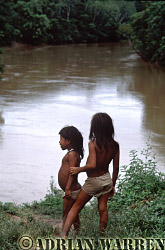
Waorani Children, rio Cononaco, 1993
Dayuma's son Sam wanted to establish some tourist visits to traditional living Waorani. His attentions focussed on Caempaede's group, since they had spent a short time at the Protectorate and had therefore already experienced some contact. Sam promised them a steady flow of presents if they would move from Gabado to the Cononaco river, which was less remote for Sam's tours and where one of the oil companies had built a large airstrip. Caempaede's group moved, and a few tourists began to trickle in on sporadic visits. Some of the visitors however also brought colds and flu, resulting in several deaths in Caempaede's group. Jim Yost, whose relationship with Caempaede's group was by now very close, travelled back and forth to treat the sick, but the Waorani had no resistance to these simple diseases, and more people died. After these bad experiences, Caempaede moved his group upriver, away from the airstrip, to keep away from outsiders and their diseases.
Exploration for oil, which had by now been going on for almost forty years, had become a real threat to Waorani lands. Through the sixties and seventies, many international companies were becoming involved, working in increased safety since so many Waorani had been persuaded to move off the land to the Protectorate. Although Tagae's group continued to kill all who came near, he and the other remaining isolationist Waorani groups were losing ground. The oil companies would soon penetrate Waorani lands everywhere, cutting a criss-cross network of trails every kilometre or so.
|
As outsiders continued their relentless advance on to Waorani lands, Jim decided it was time to document the traditional way of life of Caempaede's group on film before it was too late. Fifty-year old Caempaede was still living as his ancestors had for generations untold, although now in peace rather than in war. His community still hunted with blowguns and spears, planted gardens, relied heavily upon kin relationships for survival, and held a thorough and deep understanding of their environment. |
Caempaede's group were still a people who were living in perfect equilibrium with the forest, which in turn provided everything they needed for their daily lives. But for how much longer this traditional life would continue was difficult to predict.
|
Jim worked with a team from the BBC in 1982 to film a short sequence on the Waorani for David Attenborough's "Living Planet" series. Then, by chance, Jim was contacted by Grant Behrman, a South African living in the USA, who wanted to organise an expedition in 1983 to visit the Waorani. It seemed a good opportunity to make a full length documentary film, and the BBC again became involved. The American Museum of Natural History in New York wanted to create an exhibit on the Waorani so the task of making a collection of traditional artefacts was added to the expedition's agenda. A medical study was also undertaken. It became a huge project and Jim was concerned about the sociological impact of a team of seven cowode with a mountain of equipment descending on a small community of Waorani. |
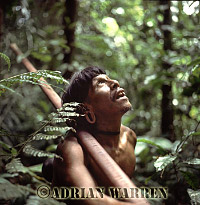
Caempaede hunting with Blowgun, 1983
|
Jim knows that tourists often brag that they had "no impact" upon the Waorani, because they left nothing behind, but such simplistic notions are foolish. Those who deny the typical tourist pocket knife, backpack, camera or clothing establish a sense of self-deprivation among the Waorani, one that motivates them to seek those goods at all costs, even at the cost of a traditional way of life. All contact carries consequences, some bad, some good; only those who are sensitive enough to be aware of that fact can take steps to try to ensure that their impact is more positive than negative. |
By 1985, the traditional way of life had almost disappeared, with the exception of Tagae's group, who were still living in secret isolation, somewhere along the Curaray river. Their days were numbered though as the outside world encroached on traditional Waorani lands from all sides. Oil companies, colonists, missionaries, and travelers threatened the privacy that Taga's group sought to maintain. In 1987, two Ecuadorian missionaries with several years' experience working among Waorani communities, Capuchin priest Padre Alexandro La Baca and Nun Ines Arango, hoped to contact Tagae's group before the devastation brought by oil exploration drove them to extinction, or into violent confrontations with oil men. In full knowledge of Tagae's fearsome reputation, and the fact that no one who had approached them had ever come out alive, the two missionaries were dropped by an oil company helicopter close to Tagae's settlement. Two days later, the air crew returned to find the dead bodies of both. They had been speared to death. It was predictable, perhaps, but at the same time tragic. Reprisals by the oil companies or the military were feared, and indeed may have happened. For Tagae's group, the writing was on the wall.
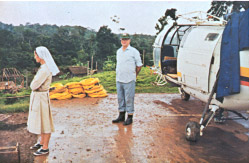
Sister Ines Arango and Padre Alejandro
La Baca
just before attempting contact with the Tagaeidi, 1987
Pressure from outsiders continued to increase, driven by a relentless thirst for oil. Dramatic changes were enveloping the Waorani; the oil companies seemed unstoppable, timber harvesters were felling trees within the boundaries of their hunting grounds, diseases the Waorani never knew were challenging their health, and Spanish schools were keeping children out of the forest and teaching that the traditional Waorani ways were of no value.
Numerous outsiders, particularly Quichua and Shuar, were assuming the role of spokespersons on behalf of the Waorani around 1981, usually without the Waorani even being aware they were doing so. These "spokespersons" were representing the Waorani to the Ecuadorian government, to oil companies, to international aid organizations and to the media. At times they obligated the Waorani to things they had no knowledge of and at other times they made "requests" on behalf of the Waorani and then made off with the funds or whatever they could glean by doing so - again without Wao knowledge of it. The younger Waorani who were learning Spanish and outside ways began to realize what was happening and decided it was time to organize themselves so they could be their own representatives to the outside world. The last project Jim Yost undertook before he left Wao land in 1982 was to spend 6 months travelling from village to village talking to the Waorani about leadership issues - explaining to them about representative government, legal organization, government functions, "Federations", "Comunas", etc. Jim had leaders from other tribes like the Cofanes come and talk about their tribal organizations as well. Jim impressed upon them the need to organize if they were going to meet the exploiters head-on. The older generation saw no need to depart from their egalitarian-independent-isolationist ways, but the younger ones could see there were problems building on the horizon and became interested in organising. It was a difficult decision for Jim: on the one hand he appreciated the old way of doing things and did not want to direct change; but on the other he saw that they needed some way for each community to have its voice heard and that they needed to unite if they were to gain any control over the external forces impinging upon them. Jim urged them to form something legal that would include all communities. Eventually, the increased oil company presence brought the issue to a head. At that point Jim recommended to the oil companies that they begin interacting with an official Wao-sanctioned organization, not with isolated individuals who claimed to be Wao representatives.
In desperation, representatives
of nearly all Waorani communities travelled to Tonaempaedi. There they
held a series of meetings intending to establish their own independent
organisation, ONHAE, in order to interface directly with the now numerous
interests of outsiders impinging on their lives and their territory.
With increasing dependence on outsiders, money was beginning to assume
an importance the Waorani never previously understood. At the meetings,
feelings were strongly divided; some speakers saw advantages with the
oil companies as a source of income, others complained that the few
dollars they received was very small in comparison to the value of the
damage inflicted, and the resources being removed from their land.
|
From the beginning, a headlong scramble to access manufactured goods like clothing, axes and machetes had drawn Waorani into oil company contact. Even back in 1974, in the hopes of luring helicopters and their booty, Caempaede's group, at Gabado, built helipads with mock scribbling on sticks in imitation of helipad markers. A man called Tedecawae even composed a new song about helicopters in the hopes that singing it would induce helicopters to come bearing gifts. For nearly two decades the Waorani welcomed oil exploration because the seismic lines cleared by company crews made excellent trails for travel or hunting. In addition, the massive wealth of goods, food and new experiences attracted Waorani to seek employment with oil companies as labourers. |
|
The encroachment was increasing the pressure on the now confused Waorani to integrate. Caempaede's group moved back to the Cononaco airstrip where, in spite of the risk of diseases brought in by outsiders, they believed they would have more access to material goods; air transport for medical care; and access to schools. Little by little, as all these things began to assume an importance unknown before, they were losing their independence. |
|
The oil companies continued their encroachment on traditional lands, and the first road was constructed with astonishing speed in 1982. The road, in itself, was relatively benign. But, like the wake from a tanker, it brought with it wave after wave of colonists seeking wealth or escape from trouble elsewhere. Quichuas from the Andes, Quichuas from the rain forest, blacks and mestizos from the Ecuadorian coast, Shuar from the Ecuadorian-Peruvian border, Colombians of various stripes - they all invaded with the persistence of a horde of army ants, consuming the forest in their path. In the vanguard, clearing the way for all of these were an aggressive pack who have low regard for life in general, but for Indians and Waorani in particular. The Waorani were pushed farther and farther into the recesses of the forest. |
The disturbance of a massive influx of outside civilisation in some areas frightened away game animals the Waorani needed to hunt for food, and brought yet more diseases. The history of contact between outside civilisation and indigenous peoples is replete with epidemics taking a heavy toll. The Waorani were fortunate in that the missionaries provided medical treatment and stayed long enough to ensure that epidemics did not decimate them. At one time they were the only line of modern health-care for the Waorani, and today they are still the principal source, particularly for accidents and snakebite. The diseases the Waorani face today give ample testimony that as a people they are inextricably entwined into the international community. The latest strains of colds or influenza quickly find their way into Waorani villages. Most recently, Hepatitis D, Cerebral Malaria, and Chicken Pox, all unknown only a decade ago, have swept through Waorani communities as a result of tourist visits and Waorani travels or work among the cowode.
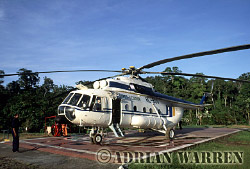
Maxus Oil company helicopter,
Waorani territory, Ecuador, 1993
Outside civilisation also brought pollution. There was no protection for the Waorani against sewage from upstream colonists or oil spillage that caused serious and toxic contamination of water supplies. As if that was not enough, an extensive mining programme was proposed to extract gold, uranium, vanadium, lead, zinc, copper, gypsum, clay, sulphur, bentonite and phosphate. Although the Ecuadorian government ceded legal right to the Waorani for some of their ancestral lands, a total disregard of law and an all-pervading corruption erode the borders of even that concession.

Oil installation, Waorani territory,
Ecuador, 1993
Dayuma, and a Waorani called Moi, made separate trips to Washington as representatives of the Waorani people, paid for by a team of lawyers from the Sierra Club Legal Defense Fund, to file petitions on Human Rights. It was a response to the untreated toxic waste products being dumped daily into the natural water drainage in Waorani territory. Their journeys had begun deep in the Ecuadorian Amazon and ended in Washington DC.. Travelling on foot, canoe, bus, train and aeroplane, they had crossed centuries. Tucked into Moi's hand woven palm string bag he had brought from home were his passport, toothbrush, bird feather head dress, and a letter addressed to the President of the United States of America. The letter invited the President to visit the Waorani, to explain to them why the outside world was trying to destroy them. His, and Dayuma's efforts, were in vain. They had hoped, as representatives of their people, to be received by the President, but the closest they came to meeting Bill Clinton was a cardboard effigy that a Polaroid photographer had placed for tourists outside the gates of the White House
|
By 1995, encroachment on to Waorani lands was out of control. The networks of roads had grown, opening up some seven million hectares of Waorani territory to speculators and colonists. As well as roads, thousands of hectares of forest had been cut and numerous helicopter landing sites prepared. At hundred metre intervals, explosives had been detonated to generate sound waves for seismic analysis, before drilling started. Once the wells were established, contamination from waste products was constant, and discharged onto surrounding land or open pits, from where it found its way into streams. Many streams could no longer support life, but indigenous people had no choice but to use this water for drinking and cooking. |
The Waorani, like many indigenous peoples, proved to be easy to exploit. With fundamentally very different attitudes to us they have no concept of land ownership, although they have always had a strong sense of private ownership of goods. Their economic system is one of generalised reciprocity - they have never had the need for a monetary system, since the forest has always provided their basic needs and they do not exploit it for money; and, as an egalitarian society, there are no political leaders; family groups function independently. Outsiders use obvious methods to make indigenous peoples more amenable to land exploitation: gifts are offered, but they are conditional; creating dependency and community destabilisation. They are told that they are backward, that they must change, and embrace the more dominant culture. The results of this are displacement, poverty, declining health, deterioration of community life and devaluation of traditional culture. As the younger Waorani struggle to come to terms with a new and difficult way of life, Caempaede and the other elders are the only direct link with the old ways.
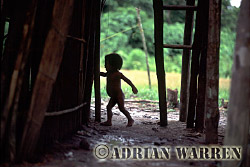
Waorani Indian boy, rio Cononaco,
Ecuador, 1993
Tagae's isolationist group are the only Waorani clinging, because of their fears, to the old lifestyle in the forest, still aggressively reacting to any attempt at contact. In 1993, two tourists disappeared close to Tagae's house; only their boat and belongings were recovered. In the same year, there was news of a German photographer who was trying to visit Tagae's group, offering large sums of money to other Waorani to help him. Outsider pressure was piling on the stress and re-igniting old inter-family feuds. Shootings and killings were routine: the military shot three Waorani; a tourist guide apparently killed another; some Waorani kidnapped a woman from Tagae's group; and when they took her back, they were ambushed and one of them was killed. More recently, in 1999, a European student was injured in an attack, but managed to escape, the first ever to get out alive. Tagae's group continue to terrorise and to kill colonists who wander too close to their territory. The future for Tagae's group is a tenuous one, and it is difficult to say for how much longer they can continue to hold out.
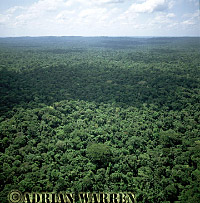
Rain Forest, rio Cononaco, Ecuador,
2002
Refugees from the Colombian drug and guerilla wars are also streaming into Ecuador. Conditioned to intense aggression as the only way to survive, many hold strong disdain for any indigenous peoples. Consequently, they start to grab Waorani lands and threaten to kill anyone who stands in their way. One Colombian colonist pointed a shotgun at the chest of a Waorani woman; three times the trigger was pulled, and three times it failed to fire. Her assailant simply walked off down the trail to his home, leaving the terrorised woman and her family too frightened to do anything about it.
There is also a more subtle but equally destructive process that threatens Waorani survival; outside tribes are now aggressively seeking Waorani spouses, so they can obtain right to Waorani lands, timber, game and fish. After contact, the Waorani quickly learned that marrying cowode brought significant benefits. A Waorani family married into a Quichua family would have access to outside goods and, especially, a place to stay during visits to the outside towns. But this system of reciprocal privilege also brought obligations. These cowode relatives gained the right to hunt and fish within Waorani territory, often carrying out hundreds of pounds of rain forest meat they have shot, or smoked fish they have poisoned or dynamited from Waorani rivers. Many have now built homes and planted gardens within Waorani lands, opening the land to even further exploitation as they bring in more relatives.
Caempaede's group continues to live, in a more or less permanent settlement, by the oil company airstrip on the Cononaco river; he is now less dependant on traditional skills although he decries the loss, and his grandchildren, like Iyowa, are now more interested in learning Spanish and integrating into the culture of the outside world. They, like the remaining 1,600 or so Waorani, most of whom now live on traditional lands deeded to them by the Government of Ecuador, do not understand the difficulties that they face. Deeded land is not protected against colonists or mining activities. It is not enough to learn to speak, to read and to write Spanish; they will have to compete in a fiercely aggressive, uncompromising outside world which is totally alien to them. That is why, tragically, so many will probably become losers. Long ago, the Waorani concluded that to protect their own interests and survive in today's world they needed to learn the national language of Ecuador, Spanish. They appealed to the government to send in schoolteachers. But, like the roads, the schools have presented the Waorani with a serious dilemma. The schools have been the most aggressive and dramatic source of permanent change in Waorani culture. The teachers have enforced change, openly demeaning Waorani traditions and values. But, even more significantly, because children from the age of four are in a classroom, they do not spend time in the forest or with their families. They are becoming isolated from their traditions, and their connection with their environment is being lost.
Waorani children, 2002
The Waorani want to adapt and to survive in the face of the changes, and they are making progress. Their organisation ONHAE is actively seeking international grants, training, and fighting for their rights. They are looking for ways to create a sustainable economy. The Waorani are survivors and are trying to flex with the massive changes around them. They are confronting issues unknown to the tribe scarcely a decade ago: they have moved from an egalitarian society, with no formal leadership, to a society that is learning to utilize Western practices and institutions, like grants, law, and education, in order to try to maintain their own dignity and integrity in the face of severe pressures. As a united people, the naive forest dwellers of a generation ago are becoming quite adept at political maneuvering, even in the face of huge global corporations. In an effort to discover less destructive sources of income, the Waorani are aggressively seeking to develop ecotourism. They have travelled to the USA, to Peru, Brazil and Costa Rica to learn how to develop it. For generations, rumours and fears of potential hostilities from other villages fuelled violence. But when the Waorani gained access to faster travel, and especially to the instant communication possible through two-way radios, they were able to address the rumours and fears more effectively. Today, two-way radios are pivotal in preventing violence, as one village knows what the other is doing, keeping suspicions down. The Waorani have learned that roads not only give them easy access to the outside, but they also give the outside easy access to them - to their land and its resources. To avoid this outside exploitation, they are rejecting more oil company roads, turning to river travel with outboard motors. They have also built thirteen airstrips scattered over their territory. Symbolic of their pride, confidence, and initiative they are now actively seeking their own aeroplane and pilot training.
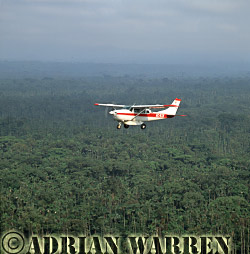
MAF Cessna
206 over the forest
Jim Yost, among the first to make peaceful contact with some of the more remote Waorani, continues to make regular visits to his Waorani friends. Most recently, in January 2002, he gazed out of the window of a small Cessna aircraft from the Missionary Aviation Fellowship at the familiar thatched huts below as it circled overhead Cononaco airstrip. Banking steeply, and descending through gaps between the tall trees, the Cessna landed on the bumpy airstrip, where it was quickly surrounded by excited Waorani, among them Caempaede. Jim was affectionately greeted as one of the family.
Like so many times before, Jim and his Waorani friends walk towards the huts. As the plane departs, Caempaede and Jim, sitting outside a traditional house, remember old times. Caempaede remembers vividly what happened to his mother and father: when a child of a neighbouring family died and the father decided that it was the work of evil spirits sent by Caempaede's father, two of the neighbours came in the night and speared both his parents to death. It led, as usual, to violent retaliation; a vicious circle of feuds and vendettas. Caempaede's wife Minimo remembers watching both her parents being speared to death in broad daylight. They talk about these devastating events freely; the Waorani were used to spending their lives in fear of each other, and they were terrified of outsiders too, although when they discovered that cowode were not cannibals, they became curious to know more about our way of life. Through discussions with other Waorani groups at the Protectorate who had come to know a man called Jim Yost, they realized that he was a man who could be trusted; so, when contact was made, Jim was accepted warmly and given a Waorani name: "Wadica". So he came to live with the Waorani on and off for ten years together with his family, learning to speak their language fluently, getting to know their culture, and subsequently becoming the foremost authority on the tribe.
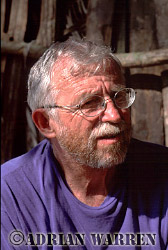 James (Jim) Yost, 2002 |
Jim Yost visits his Waorani friends at least once a year, rekindling friendships and keeping track of all the individuals and communities he has come to know and love through nearly thirty years of his life. During those thirty years, the Waorani have transitioned many centuries of sociological evolution. Embracing those gargantuan changes during a mere generation of Waorani, a bemused Caempaede, who is now over seventy years old, watches the surrounding world in the declining years of his life.
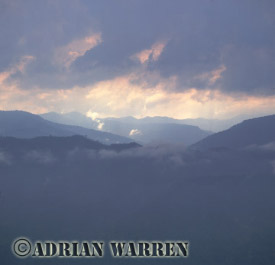
Rain Forest near Shell Mera,
rio Cononaco, Ecuador, 2002
(7,893 words)
© Adrian Warren,
Last Refuge Ltd., March 2002, in association with Dr. James Yost.
